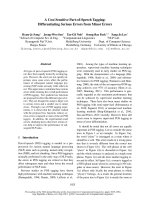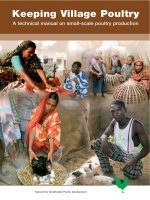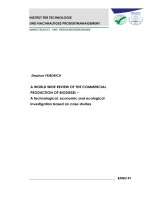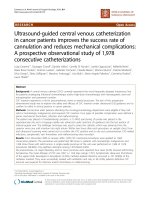Minimizing mother bulb requirement through mechanical option: A cost friendly approach of onion seed production
Bạn đang xem bản rút gọn của tài liệu. Xem và tải ngay bản đầy đủ của tài liệu tại đây (593.99 KB, 10 trang )
Int.J.Curr.Microbiol.App.Sci (2018) 7(7): 2646-2655
International Journal of Current Microbiology and Applied Sciences
ISSN: 2319-7706 Volume 7 Number 07 (2018)
Journal homepage:
Original Research Article
/>
Minimizing Mother Bulb Requirement through Mechanical Option: A Cost
Friendly Approach of Onion Seed Production
D.K. Ghosh1, L.K.N. Benukar Biswas2*, S. Das1, C.S. Kartick1 and A. Bandyopadhyay1
1
Department of Spices and Plantation Crops, 2Department of Agronomy, Bidhan Chandra
Krishi Viswavidyalaya, Mohanpur, West Bengal, India 741 252
*Corresponding author
ABSTRACT
Keywords
Onion bulb size,
Longitudinal cut,
Umbel,
Productivity,
Profitability
Article Info
Accepted:
20 June 2018
Available Online:
10 July 2018
Reduction of seed production cost of onion in India may play an important role in bridging
the demand-supply gap of onion bulb in both domestic as well as international market, but
choices to be made require appropriate cultural manipulations to reduce the mother bulb
requirement, the key cost component of seed production. A field experiment in West
Bengal, India was conducted between 2014-15 to 2016-17 on a clay loam (Alfisol) soil to
evaluate seed production using five different portions of mother bulb (whole bulb of 7080g; cross section cut at middle of 40-50g; longitudinally half cut of 35-40 g;
longitudinally one third cut of 30-35 g and small but whole bulb of 30-35g) of Sukhsagar
variety. Growth, productivity, production cost and net return generally increased with
increasing mother bulb size. However, umbels per plant, seeds per umbel, setting
percentage, test weight, seed yield and gross return were at par with using whole bulb of
70-80g and longitudinally half cut of 35-40 g. Cost analysis of onion seed production
shows 70.86% share alone in procuring mother bulb. Thus, longitudinally half cut reduced
mother bulb requirement by 50%. Net return, benefit cost ratio, benefit in terms of rupees
or grams per unit rupee investment in mother bulb were higher than that of using whole
mother bulb. Based on economic considerations alone, half cut bulb of 35-40 g weight can
be recommended instead of using conventional whole bulb of 70-80g weight as cost saving
onion seed production options with a possibility of doubling area.
Introduction
Onion is one of the important bulbous crops in
India earning foreign currency through export.
India is the second largest producers of onion
(Allium cepa L.) in the world next to China
with 20 m t annual bulb production from 1.17
m ha (2015-16). The average productivity
(17.32 t ha-1) is very low as compared to USA
(41.12 t ha-1). This is mainly because of the
growing of short day varieties in large scale
along with the limited availability of quality
seeds. Farmers, in India, are producing more
than 90% seeds from their own sources. Size
and weight of the bulb is one of the most
important factors affecting onion seed
production (Khodadadi, 2012; Asduzzaman et
al., 2012). Higher is the size and weight of
2646
Int.J.Curr.Microbiol.App.Sci (2018) 7(7): 2646-2655
bulb, higher is the seed yield in onion (Ranjan
et al., 2016; Singh and Singh; 2012 and
Agarwal et al., 2010). There are some studies
on effect of planting date and mulching
(Anisuzzaman et al., 2009), of mineral
nutrition (Ali et al., 2007), of enzyme (De et
al., 2013), of organics (Naik et al., 2014) on
onion. Though the main cost component of
onion seed production is the mother bulb but
most of the previous works have focused on
specific said aspects of onion seed production.
Studies providing an option to reduce the
mother bulb requirement through mechanical
manipulation have remained relatively rare in
the scientific literature, but they are needed for
understanding options for reducing production
cost vis-a-vis horizontal expansion of onion
area in India. Here we present an effect of five
different portions of mother bulb (whole bulb
of 70-80g; cross section cut at middle of 4050g; longitudinally half cut of 35-40 g;
longitudinally one third cut of 30-35 g and
small but whole bulb of 30-35g) of Sukhsagar
variety on growth, productivity and
profitability.
Materials and Methods
A field experiment for 3 years was conducted
between 2014 to 2017 at the farm of the
Bidhan Chandra Krishi Viswavidyalaya,
Kalyani, Nadia, West Bengal, India, located in
the Gangetic flood plain of the Eastern IGP
(Lat. 23.50N, Long. 890E, Elev. 9.75m a.s.l.).
Prior to the experiment, the field had been
under irrigated rice-onion cropping for 5
years. The soil of the experimental field is a
very deep, well-drained, clay loam with 44%
sand, 28% silt and 28% clay in the surface
layer (0–15 cm). Initial properties of a
composite soil sample collected at the
beginning of the field experiment where 4.9 g
kg-1 organic carbon (Walkley-Black), 0.48 g
kg-1 total N (Kjeldahl), 44 kg ha-1 available P
(Bray-1), 149 kg ha-1 available K (1N NH4acetate), and a pH of 6.9 (1:2.5 soil: water)
were recorded. Weather during crop season
(November to April) was almost stable during
the period of experimentation except
temperature (Fig. 1). Higher temperature was
recorded during 2015-16. Average annual
rainfall at this place over last 3 years is 1582
mm. Mean monthly temperature over the
experimental period ranges from 9.30C
(minimum) in February to 39.00C (maximum)
in May. Mean daily maximum and minimum
relative humidity over the period was 60% and
93%, respectively.
The experiment was laid out in a randomized
complete block design with 9 m X 6 m plots
replicated four times. Five different portions
of mother bulb (whole bulb of 70-80g-T1;
cross section cut at middle of 40-50g-T2;
longitudinally half cut of 35-40 g-T3;
longitudinally one third cut of 30-35 g-T4 and
small but whole bulb of 30-35g-T5) of
Sukhsagar variety were used as propagating
material (Fig. 2).
The field was ploughed thoroughly by tractor
to a fine tilth by giving four ploughings
followed by leveling. The field was then
divided into beds and channels to avoid water
logging which affects production and quality
of seeds. 25 tones of FYM ha-1 were applied at
the time of land preparation. Recommended
dose of fertilizers (125: 60: 90 @ N: P2O5:
K2O kg ha-1) were applied in two split doses.
½ N, full P2O, and ½ K2O as basal and rest at
25 days after planting as top dressing and
earthing up was followed after topdressing.
Treated mother bulbs were planted within first
fortnight of November. Need based irrigation
and eco friendly plant protection measures
were taken. Diseased and off-type plants were
rouged out before flowering for quality seed
production. Five plants from each plot were
selected for recording of spikes per plant,
spike length, basal diameter of spike, umbel
diameter, setting %, test weight and seed
yield. Prices of individual inputs and outputs
2647
Int.J.Curr.Microbiol.App.Sci (2018) 7(7): 2646-2655
(diesel @ Rs 63.25 per liter, labor @ Rs 170
per 8-h day, mother bulb @ Rs 40000 per ton,
Urea @ Rs. 6.5 per kg, MOP @ Rs 12 per kg,
SSP @ Rs 8 per kg, Imida-chloroprid @ Rs
1400 per liter, Propiconazole @ Rs 800 per
liter) were assumed to be stable during the
experimental period. Family labor at the mean
wage rate of hired labor was included in the
cost calculations, thus ignoring possible
opportunity costs. Treatment wise detailed
production costs were shown in Table 1. Net
return or profit was calculated by subtracting
production cost from the gross value of the
produce. Prices used for harvest products were
average prices observed during the
experimental period. The benefit: cost ratio
(BCR) was calculated by dividing the net
return by the production cost. Statistical
analysis for each variable was conducted as
per the procedure given by Gomez and Gomez
(1984). Wherever the results were significant,
least significant differences (LSD) were
worked out at probability level p 0.05 using
the ANOVA. The non-significant treatment
differences were denoted as NS.
were recorded under treatment T1 followed by
T3 (4.7) which are at par with each other.
Treatment T4 recorded lowest number of
spikes plant-1(2.6). Regarding spike length,
maximum spike length of 94cm was recorded
under treatment T3 followed by T1 and T2
which are at par with each of three. T5 (e.g.
small whole bulb, wt.30-35g) recorded
minimum spike length of 75cm. Basal
diameter of spike was recorded maximum
(7.69cm) under treatment T1 and minimum
(6.14cm) was recorded in treatment T4.
Treatment wise seeds per umbel were
recorded maximum under treatment T1 (593
numbers) followed by T3 (578 numbers)
which are at par with each other. Seed setting
% per umbel was also recorded maximum
(73%) in treatment T1 followed by T3 (71%)
and lowest in T5 (54%). Test seed weight was
also recorded highest (3.42g) in treatment T1
followed by T3 (3.4g) which are at par with
each other and lowest seed weight was
recorded by T5 (2.81g).
Results and Discussion
Onion seed yield was also in agreement with
the growth performance. Equivalent seed
production was observed between using
standard whole bulb (70-80g) and its
longitudinal ½ cutted bulb. Year wise onion
seed production was maximum in 2014-15
(0.571 t ha-1), followed by 2016-17 (0.481 t
ha-1), and lowest seed yield was recorded in
the year 2015-16 (0.435 t ha-1), (Table 4).
From the year wise mean data presented in
Table 4 it is revealed that T1 recorded
maximum seed yield of 0.732 t ha-1 followed
by T3 (0.696 t ha-1) and the most interesting
fact is that both the treatments are statistically
at par with each other. Treatment T4 recorded
minimum seed yield of 0.285 t ha-1.
Temperature at reproductive stage is one of
the most important factors for onion seed
production. From the weather data, it was
observed that in 2014-15 during reproductive
Growth and yield component
Mother bulb size as well as type of cutting of
bulbs influenced the growth and development
of onion. Higher is the size better is the
performance. Among the cutting pattern, half
longitudinal cut outperformed cross section at
middle or one third longitudinal cuttings in
terms of spikes per plant, basal diameter of the
spike, umbel diameter, seeds per umbel ,
setting percentage and test weight. It is also
observed that half longitudinal cut bulb of 3540g weight was at par with planting whole
bulb of standard size of 70-80 g weight in
terms of growth parameters evaluated. The
pooled data over three years (2014-15 to
2016-17) presented in Table-3 reveals that
maximum number of spikes plant-1 (4.92)
Productivity
2648
Int.J.Curr.Microbiol.App.Sci (2018) 7(7): 2646-2655
stage maximum temperature was up to 18.70C
whereas it was up to 25.60C during 2015-16
(Fig. 1) and this variation in terminal heat
condition greatly influenced the seed
development and production. Olani Nikus and
Fikre Mulugeta (2010) and Khokhar (2014)
had reported that temperature ranges between
4.5-14oC with low humidity is favorable for
seed stalk formation. If this type of
temperature prevails for longer periods then
each plant will produce more number of
flowers in each umbel. Higher temperature
prevails long time during flowering season can
prevent flowering followed by flower abortion
resulted in low seed yield and this was clearly
reflected in the year 2015-16 where
temperature range was maximum (14.825.60C) in comparison with the years 2014-15
and 2016-17 and as a result over all vegetative
growth of the plants, seed setting percentage,
and seed yield were minimum in 2015-16
irrespective of any treatments. Yield
components and productivity in T1 and T3 was
equivalent. More number of spikes plant-1 and
seed yield recorded in treatment T3, may be
due to the removal of dominancy of the apical
buds by imposing longitudinal cut which
allows auxiliary buds or side buds with better
growth and development of more spike and
ultimately better seed yield. Thimann and
Skoog (1934) reported that apical bud
produces the plant hormone auxin (IAA)
which regulates apical dominance by
inhibiting the growth of the lateral buds
further down on the stem towards the axillary
bud. The imposition of inhibition of auxin
mediated apical dominancy on main bud with
longitudinal cut in mother bulb may promote
cytokine mediated initiation of more lateral
buds.
Booker et al., (2003) reported that auxin is
predominantly produced in the growing shoot
apex and diffuses into lateral buds through
phloem
and
prevents
elongation.
Physiologically, in onion the stem is shortened
down to a disc which is often called the basal
plate or reduced stem (Fig. 2 and 3). The leaf
bases are attached to the upper surface of the
reduced stem and roots arise around the edge.
The auxiliary buds or side buds always
developed at the node where the leaves attach
and in the center there will be one apical bud
or main bud which can grow first due to its
better vigor and apical dominancy over
auxiliary or side buds. This observation
confirms the findings of Razdan (2003) where
he had mentioned that the development of
auxiliary meristems is inhibited by apical
dominance. Burrows (1989) reported that
those auxiliary meristems are commonly the
source of buds formation in nature especially
when the apical shoots are damaged or
injured. Singh et al., (2011) recorded that in
banana macro and micro propagation
decapitation and wounding of shoot tips
overcome the apical dominance and encourage
auxiliary bud proliferation. Hussein (2012)
also reported that longitudinally bud splitting
technique in banana during tissue culture
process increases the number of explants. This
is thought to promote buds proliferation by
breaking the apical dominance (Wooley and
Wareing, 1972).
Economics:
From the figure 3, it is clear that the mother
bulb is the key cost component of onion seed
production contributing 70.86% alone
followed by labor (18.52%). Availability as
well as purchasing capacity of this costly
propagating material actually controls the area
coverage of this crop. Here, different portions
and/or sizes of mother bulb were tried to
reduce bulb requirement for horizontal
expansion without compromising vertical
stability. Treatment wise percentage of cost
involved in mother bulb varies from 44 to 69
% in comparison to 71% in conventional (Fig.
3). So, seed material cost may be reduced with
this mechanical manipulation.
2649
Int.J.Curr.Microbiol.App.Sci (2018) 7(7): 2646-2655
Table.1 Input requirement of onion seed production with different size &/or portion of mother
bulb in a field experiment in West Bengal, India
Item
Treatment wise Input requirement
T1
T2
T3
T4
T5
Diesel (l ha-1)
82.5
82.5
82.5
82.5
82.5
Labor (8-h days ha-1)
369
429
444
399
309
Mother Bulb (t ha-1)
6
6
3
2
3
FYM (t ha-1)
25
25
25
25
25
Fertilizer N (kg ha-1)
125
125
125
125
125
Fertilizer P2O5 (kg ha-1)
60
60
60
60
60
Fertilizer K2O (kg ha-1)
90
90
90
90
90
Imida-chloroprid 17.8 sl(l ha-1)
0.9
0.9
0.9
0.9
0.9
Propiconazole25% EC(l ha-1)
2.7
2.7
2.7
2.7
2.7
T1: Whole bulb (70-80 g); T2: Cross section cut at middle (40-50g); T3: Longitude cut (half) (35-40 g); T4:
Longitude cut (one third) (30-35 g); T5: Small but whole bulb (30-35 g)
Table.2 Production cost (Rs ha-1) of onion seed production with different size &/or portion of
mother bulb in a field experiment in West Bengal, India
Item
Diesel
Labor
Mother Bulb
FYM
Fertilizer N
Fertilizer P2O5
Fertilizer K2O
Imida-chloroprid
Propiconazole25% EC
Depreciation
Tax
Total
T1
5218
62730
240000
20000
1766
3000
1800
1260
2160
613
147
338694
Treatment wise production cost (Rs ha-1)
T2
T3
T4
5218
5218
5218
72930
75480
67830
240000
120000
80000
20000
20000
20000
1766
1766
1766
3000
3000
3000
1800
1800
1800
1260
1260
1260
2160
2160
2160
613
613
613
147
147
147
348894
231444
183794
T5
5218
52530
120000
20000
1766
3000
1800
1260
2160
613
147
208494
T1: Whole bulb (70-80 g); T2: Cross section cut at middle (40-50g); T3: Longitude cut (half) (35-40 g); T4:
Longitude cut (one third) (30-35 g); T5: Small but whole bulb (30-35 g)
Table.5 Effect of mother bulb portion on economics of onion seed production
Mother bulb portion
T1
T2
T3
T4
T5
LSD(0.05)
Production cost
(Rs ha -1)
338694
348894
231444
183794
208494
40463
Gross return
(Rs ha -1)
878400
520800
835200
342000
397200
90144
Net return (Rs
ha -1)
539706
171906
603756
158206
188706
B:C ratio
1.59
0.49
2.61
0.86
0.91
0.24
T1: Whole bulb (70-80 g); T2: Cross section cut at middle (40-50g); T3: Longitude cut (half) (35-40 g); T4:
Longitude cut (one third) (30-35 g); T5: Small but whole bulb (30-35 g)
2650
Int.J.Curr.Microbiol.App.Sci (2018) 7(7): 2646-2655
100
Max Temp (0C)
Max RH (%)
Min Temp (0C)
Min RH (%)
Mean Temp (0C)
SS(Hr/day)
80
60
40
20
0
Standard week (2014-2015)
Standard week (2015-2016)
Standard week (2016-2017)
Fig.1 Weekly average temperature, humidity, sun shine hour, rainfall and evaporation during
onion season of 2014-15, 2015-16 and 2016-17
2651
Int.J.Curr.Microbiol.App.Sci (2018) 7(7): 2646-2655
T1: whole bulb of 70-80g; T2: cross section cut at middle of 40-50g; T3: longitudinally half cut
of 35-40g; T4: longitudinally one third cut of 30-35g and T5: small but whole bulb of 30-35g
Fig.2 Treatment wise portion and/or size of mother bulb and parts of onion bulb
Table.3 Effect of mother bulb portion on growth and yield components of onion in a field
experiment, West Bengal, India (Pooled over 2014-17)
Bulb
portion
and size
Spikes
Plant-1
Spike
length
(cm)
T1
T2
T3
T4
T5
LSD (0.05)
4.92
3.77
4.7
2.6
3.11
0.53
93
93
94
88
75
11
Basal
diameter
of Spike
(cm)
7.69
7.34
7.38
6.14
6.47
0.86
Diameter
of the
umbel
(cm)
24.61
18.58
21.04
13.75
16.30
2.23
Seeds
umbel-1
Setting
%
Test
weight
(g)
593
490
578
479
495
63
73
68
71
57
54
7.7
3.42
3.31
3.4
2.86
2.81
0.37
T1: Whole bulb (70-80 g); T2: Cross section cut at middle (40-50g); T3: Longitude cut (half) (35-40 g); T4:
Longitude cut (one third) (30-35 g); T5: Small but whole bulb (30-35 g)
2652
Int.J.Curr.Microbiol.App.Sci (2018) 7(7): 2646-2655
Table.4 Effect of mother bulb portion on onion seed yield in a field experiment, West Bengal,
India
Mother bulb
portion
T1
T2
T3
T4
T5
Mean
LSD (0.05) (year)
SD (0.05)
2014-2015
0.819
0.472
0.811
0.366
0.387
0.571
Year
0.038
Onion seed yield (t ha-1)
2015-2016
2016-2017
0.654
0.723
0.387
0.443
0.608
0.669
0.231
0.258
0.293
0.313
0.435
0.481
Mother bulb portion
Interaction
0.041
0.034
Pooled
0.732
0.434
0.696
0.285
0.331
T1: Whole bulb (70-80 g); T2: Cross section cut at middle (40-50g); T3: Longitude cut (half) (35-40 g); T4:
Longitude cut (one third) (30-35 g); T5: Small but whole bulb (30-35 g)
T1: Whole bulb (70-80 g); T2: Cross section cut at middle (40-50g); T3: Longitude cut (half)
(35-40 g); T4: Longitude cut (one third) (30-35 g); T5: Small but whole bulb (30-35 g)
Fig.3 Cost component of onion seed production under conventional method and treatment wise
cost share(%) in mother bulb over total production cost in a field experiment in West Bengal,
India
2653
Int.J.Curr.Microbiol.App.Sci (2018) 7(7): 2646-2655
Production cost is higher in T1 (Rs. 338694
ha-1) and T2 (Rs. 348894 ha -1) due to use of
bigger size mother bulb. Cost of cultivation
was reduced by 32% in T3 (Rs 231444); by
46% in T4 (Rs 183794) and by 38 % in T5 (Rs
208494) over conventional T1. Gross return
directly proportional to seed yield and
significantly affected by different bulb size
and / or mother bulb. It ranged from Rs.
342000 in T4 to Rs 878400 in T1. Gross return
in T1 and T3 were at par. Net return and BCR
were the highest in T3 (Rs 603756; 2.61)
followed by in T1 (Rs 539706; 1.59). Net
return was directly related to the price that the
producer received for the product and
inversely related to the production cost. Both
net return and BCR were highest for
longitudinal half cut in mother bulb, mainly
due to cost reduction but equivalent seed
production with conventional system. Among
all treatments, economic performance of
longitudinal half cut was the best in terms of
both net return and BCR (Table 5). In
contrast, the lowest BCR was observed for
cross sectional half cut (0.49 t) should be
noted, however, that the average production
costs and economic returns shown in Table 2
and Table 5 only illustrate the major
differences among treatments. Annual price
fluctuations are likely to cause significant
variation in the economic performance and
also varying economic risk.
In conclusion, there is potential for doubling
onion seed production area utilizing the
presently available mother bulb. Growth,
productivity, production cost and net return
generally increased with increasing mother
bulb size. However, umbels per plant, seeds
per umbel, setting percentage, test weight,
seed yield and gross return was at par with
using whole bulb of 70-80g and
longitudinally half cut of 35-40 g. Cost
analysis of onion seed production shows 71%
share alone in procuring mother bulb in
farmers’ practice. Thus, longitudinally half
cut reduced mother bulb requirement by 50%
and production cost significantly reduced than
that of using whole bulb. Net return and
benefit cost ratio were significantly higher in
this half cut tuber than that of using whole
mother bulb. This finding can reduce cost of
cultivation by 28% without compromising the
seed yield. Considering this remunerative
aspect, half cut bulb of 35-40 g weight can be
recommended instead of using conventional
whole bulb of 70-80g weight as cost saving
onion seed production options with a
possibility of doubling area of seed
production with the existing supply of mother
bulb. From the above experiment it can be
concluded
that
treatment
T3
e.g.
longitudinally ½ cutted onion bulb (wt 4550g) is able to yield almost equivalent
quantity of seed (0.696T/ha) with less cost of
production as compared with the big whole
bulb of 70-80g size and may be suggested as
suitable mother bulb with reduced cost to be
used for large scale onion seed production
program.
References
Agarwal, A., Gupta, S. and Ahmed, Z. 2010.
Effect of bulb size and planting
geometry on seed yield and economics
of onion (Allium cepa). Indian J Agr Sci
80(4): 333-334.
Ali, M. K., Alam, M. F., Alam, M. N., Islam
M. S., and Khandaker, S. M. A. T.
2007. Effect of Nitrogen and Potassium
Level on Yield and Quality Seed
Production of Onion. Journal of Applied
Sciences Research, 3(12): 1889-1899.
Anisuzzaman, M., Ashrafuzzaman, M., Ismail,
M. R., Uddin, M. K., Rahim, M. A.
2009. Planting time and mulching effect
on onion development and seed
production. Afr. J. Biotechnol 8(3): 412416.
Asduzzaman, M. D., Hasan, D., Hasan, M .D.
and Moniruzzaman, M. D. 2012. Effect
of bulb size and plant spacing on seed
2654
Int.J.Curr.Microbiol.App.Sci (2018) 7(7): 2646-2655
production of onion (Allium cepa L).
Bangladesh J. Agric. Res., 37(3): 405414.
Ashish Ranjan, Mahender Pal and Singh, K. P.
2016. Seed production technique of
onion, Rashtriya Krishi | 11 (1) /p 119.
Booker, Jonathon. Steven, Chatfield. Ottoline,
Leyser.2003. Auxin acts in xylemassociated or medullary cells to mediate
apical dominance. Plant Cell. 15: 495–
507. Doi: 10.1105/tpc.007542.
Burrows, G. 1989. Developmental Anatomy of
Axillary Meristems of Araucaria
Cunninghamii. Released from Apical
Dominance Following Shoot Apex
Decapitation in Vitro and in Vivo.
Botanical
Gazette,
150:369-377.
/>De, S., Manna, D., Sankar, A. and Maity, T. K.
2013. Influence of biozyme on growth,
yield and quality of onion (Allium cepa
L.) cv. Sukhsagar. The Bioscan. 8(4):
1271-1273.
Gomez, K. A. and Gomez, A. A. 1984.
Statistical Procedures for Agricultural
Research. John Wiley and Sons, New
York, 680p.
Singh, H. P., Uma, S., Selvarajan, R. and
Karihaloo, J. L. 2011. Micro
propagation for Production of Quality
Banana Planting Material in Asia
Pacific. Asia-Pacific Consortium on
Agricultural Biotechnology (APCoAB),
New Delhi, India. P. 92.
Hussein, N. 2012. Effects of Nutrient Media
Constituents
on
Growth
and
Development of Banana (Musa spp.)
Shoot Tips Cultured in Vitro. African
Journal of Biotechnology, 11: 90019006.
Khodadadi, M. 2012.The effects of planting
date and mother bulb size on
quantitative and qualitative seed traits of
onion red variety. Int. J Agr. Res Rev
2(4): 324-327.
Khokhar, K. 2014. Flowering and Seed
Development
in
Onion—A
Review. Open
Access
Library
Journal, 1,
1-13.
doi: 10.4236/oalib.1101049.
Nail, V. R., Patel, P. B. and Patel, B. K. 2014.
Study on effect of different organics on
yield and quality of organically grown
onion. The Bioscan. 9(4): 1499-1503.
Olani Nikus and Fikre Mulugeta. 2010. Onion
Seed Production Techniques - A
Manual for Extension Agents and Seed
Producers,
published
by
©FAO‐CDMDP, 2010, p-3.
Razdan, M. K. 2003. Introduction to Plant
Tissue Culture. Science Publishers.
Singh, R. K. and Singh, S.K. 2012. Producing
onion seed for rich harvest. Indian Hort.
57: 11-23.
Thimann, K.V. and Skoog, F. 1934. On the
inhibition of bud development and other
functions of growth substance in Vicia
faba. Proceedings of the Royal Society
B. 114:
317–339. Doi:10.1098/rspb.
1934.0010.
Woolley, D. J. and Wareing, P. F. 1972. The
Interaction between Growth Promoters
in Apical Dominance. New phytologist,
71: 781-793. />j.1469-8137.1972.tb01957.x.
How to cite this article:
Ghosh, D.K., L.K.N. Benukar Biswas, S. Das, C.S. Kartick and Bandyopadhyay, A. 2018.
Minimizing Mother Bulb Requirement through Mechanical Option: a Cost Friendly Approach
of Onion Seed Production. Int.J.Curr.Microbiol.App.Sci. 7(07): 2646-2655.
doi: />
2655









